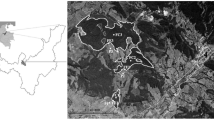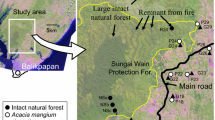Abstract
Little is known about how tropical land-use systems contribute to the conservation of functionally important insect groups, including dung beetles. In a study at the margin of Lore Lindu National Park (a biodiversity hotspot in Central Sulawesi, Indonesia) dung-beetle communities were sampled in natural forest, young secondary forest, agroforestry systems (cacao plantations with shade trees) and annual cultures (maize fields), each with four replicates (n = 16 sites). At each site we used 10 pitfall traps, baited with cattle dung, along a 100 m transect for six 3-day periods. The number of trapped specimens and species richness at the natural forest sites was higher than in all land-use systems, which did not significantly differ. Each land-use system contained, on average, 75% of the species richness of the natural forest, thereby indicating their importance for conservation. However, a two-dimensional scaling plot based on NESS indices (m = 6) indicated distinct dung beetle communities for both forest types, while agroforestry systems and annual cultures exhibited a pronounced overlap. Mean body size of dung beetles was not significantly influenced by land-use intensity. Five of the six most abundant dung beetle species were recorded in all habitats, whereas the abundance of five other species was significantly related to habitat type. Mean local abundance and number of occupied sites were closely correlated, further indicating little habitat specialisation. The low dung beetle diversity (total of 18 recorded species) may be due to the absence of larger mammals in Sulawesi during historical times, even though Sulawesi is the largest island of Wallacea. In conclusion, the dung beetle fauna of the lower montane forest zone in Central Sulawesi appears to be relatively robust to man-made habitat changes and the majority of species did not exhibit strong habitat preferences.
Similar content being viewed by others
References
E. Andresen (2002a) ArticleTitleEffect of forest fragmentation on dung beetle communities and functional consequences for plant regeneration Ecography 26 87–97
E. Andresen (2002b) ArticleTitleDung beetles in a Central Amazonian rainforest and their ecological role as secondary seed dispersers. Ecological Entomology 27 257–270
J. Beck C.H. Schulze K.E. Linsenmair K. Fiedler (2002) ArticleTitleFrom forest to farmland: diversity of geometer moths along two habitat gradients on Borneo Journal of Tropical Ecology 18 33–51
T. Boulinier J.D. Nichols F.R. Sauer J.E. Hines K.H. Pollock (1998) ArticleTitleEstimating species richness: the importance of heterogeneity in species detectability Ecology 79 1018–1028
C.A. Brühl (2001) Leaf litter ant communities in tropical lowland rain forests in SabahMalaysia: effects of forest disturbance and fragmentation. Ph.D. Thesis University of Würzburg Würzburg, Germany
K.R. Clarke (1993) ArticleTitleNon-parametric multivariate analyses of changes in community structure Australian Journal of Ecology 18 117–143
B.J. Coates K.D. Bishop D. Gardner (1997) A field guide to the birds of Wallacea Dove Publications Alderley, Australia
Colwell R.K. 2000. EstimateS – Statistical estimation of species richness and shared species from samples. Version 6.0b1. http:/viceroy.eeb.uconn.edu/estimates.
R.K. Colwell J.A. Coddington (1994) ArticleTitleEstimating terrestrial biodiversity through extrapolation Philosophical Transactions of the Royal Society of London Series B 345 101–118 Occurrence Handle7972351 Occurrence Handle1:STN:280:DyaK2M%2Fmt1GltA%3D%3D
T.F. Cox M.A.A. Cox (1994) Multidimensional Scaling Monographs on Statistics and Applied Probability 59 Chapman & Hall London
A.J. Davis (2000) ArticleTitleSpecies richness of dung-feeding beetles (Coleoptera: Aphodiidae, Scarabaeidae, Hybosoridae) in tropical rainforest at Danum Valley, SabahMalaysia Coleopterist Bulletin 54 221–231
A.J. Davis S.L. Sutton (1989) ArticleTitleThe effects of rainforest canopy loss on arboreal dung beetles in Borneo: implications for the measurement of biodiversity in derived tropical ecosystems Diversity and Distribution 4 167–173
A.J. Davis J.D. Holloway H. Huijbregts J. Krikken A.H. Kirk-Spriggs S. Sutton (2001) ArticleTitleDung beetles as indicators of change in the forests of Northern Borneo Journal of Applied Ecology 38 593–616
R.K. Didham J. Ghazoul N.E. Stork A. Davis (1996) ArticleTitleInsects in fragmented forests: a functional approach Trends of Ecology and Evolution 11 255–260
A. Estrada R. Coates-Estrada (2002) ArticleTitleDung beetles in continuous forest, forest fragments and in agricultural mosaic habitat island at Los Tuxtlas, Mexico Biodiversity and Conservation 11 1903–1918
J.F. Grassle W. Smith (1976) ArticleTitleA similarity measure sensitive to the contribution of rare species and its use in investigation of variation in marine benthic communities Oecologia 25 13–22
G. Halffter M.E. Favila (1993) ArticleTitleThe Scarabaeinae (Coleoptera): an animal group for analysing, inventorying and monitoring biodiversity in tropical rainforest and modified landscapes Biology International 27 15–21
I. Hanski (1982) ArticleTitleDynamics of regional distribution: the core and satellite species hypothesis Oikos 38 210–221
I. Hanski (1989) Fungivory, fungi insects, and ecology N. Wilding N.M. Collins P.M. Hammond J.F. Werber (Eds) Insect-Fungus Interactions Academic Press New York 25–68
I. Hanski Y. Cambefort (Eds) (1991) Dung Beetle Ecology Princeton University Press Princeton, New Jersey
I. Hanski J. Krikken (1991) Dung beetles in tropical forests in South-East Asia I. Hanski Y. Cambefort (Eds) Dung Beetle Ecology Princeton University Press Princeton. New Jersey 179–197
I. Hanski J. Niemela (1990) Elevational distributions of dung and carrion beetles in Northern Sulawesi W.J. Knight J.D. Holloway (Eds) Insects and the Rain Forests of South East Asia (Wallacea) Royal Entomological Society of London London 142–152
C.J. Hill (1996) ArticleTitleHabitat specificity and food preferences of an assemblage of tropical Australian dung beetles Journal of Tropical Ecology 12 449–460
J.K. Hill K.C. Hamer L.A. Lace W.M.T. Banham (1995) ArticleTitleEffects of selective logging on tropical forest butterflies on Buru Indonesia Journal of Applied Ecology 32 754–760
J.D. Holloway (1987) ArticleTitleMacrolepidoptera diversity in the Indo-Australian tropics: geographic, biotopic and taxonomic variations Biological Journal of the Linnean Society 30 325–341
J.D. Holloway (1998) The impact of traditional and modern cultivation practices, including forestry, on Lepidoptera diversity in Malaysia and Indonesia D.M. Newbery H.H.T. Prins N.D. Brown (Eds) Dynamics of Tropical Communities, 37th Symposium of the British Ecological Society Blackwell Science London 567–597
J.D. Holloway A.H. Kirk-Spring V.K. Chey (1992) ArticleTitleThe response of some rain forest insect groups to logging and conversion to plantation Philosophical Transactions of the Royal Society Series B 335 425–436
D. Holmes (2000) Deforestation in Indonesia: A Review of the Situation in 1999 The World Bank Jakarta
J.B. Hughes G.C. Daily P.R. Ehrlich (2002) ArticleTitleConservation of tropical forest birds in countryside habitats Ecology Letters 5 121–129
J. Intachat J.D. Holloway M.R. Speight (1999) ArticleTitleThe impact of logging on geometroid moth populations and their diversity in lowland forests of Peninsular Malaysia Journal of Tropical Forest Science 11 61–76
B.C. Klein (1989) ArticleTitleEffects of forest fragmentation on dung and carrion beetle communities in Central Amazonia Ecology 70 1715–1725
A.M. Klein I. Steffan-Dewenter D. Buchori T. Tscharntke (2002) ArticleTitleEffects of land-use intensity in tropical agroforestry systems on coffee flower-visiting and trap-nesting bees and wasps Conservation Biology 16 1003–1014
J.H. Lawton D.E. Bignell B. Bolton G.F. Bloemers P. Eggleton P.M. Hammond et al. (1998) ArticleTitleBiodiversity inventories, indicator taxa and effects of habitat modification in tropical rain forest Nature 391 72–76 Occurrence Handle1:CAS:528:DyaK1cXjvFansg%3D%3D
L.H. Liow N.S. Sodhi T. Elmqvist (2001) ArticleTitleBee diversity along a disturbance gradient in tropical lowland forest of South-East Asia Journal of Applied Ecology 38 180–192
M. McGeoch B.J. van Rensburg A. Botes (2002) ArticleTitleThe verification and application of bioindicators: a case study of dung beetles in a savannah ecosystem Journal of Applied Ecology 39 661–672
S. Meßner (1996) Untersuchungen zur Biodiversität der Myrmecofauna (Formicidae) im Parc National de la Comoé (Elfenbeinküste). Diploma Thesis University of Würzburg Würzburg, Germany
Ministry of State for Population and Environment of Republic Indonesia. 1992. Indonesia Country Study on Biological Diversity. Prepared for UNEP under the programme for environmental cooperation between The Republic of Indonesia and The Kingdom of Norway, Jakarta.
G.G. Musser (1987) The mammals of Sulawesi T.C. Whitmore (Eds) Biogeographical Evolution of the Malay Archipelago Oxford University Press OxfordUK 73–93
M. Nummelin I. Hanski (1989) ArticleTitleDung beetles of the Kibale ForestUganda: a comparison between virgin and managed forests Journal of Tropical Ecology 5 349–352 Occurrence Handle10.1017/S0266467400003758
T. Ochi M. Kon T. Kikuta (1996) ArticleTitleStudies on the family Scarabaeidae (Coleoptera) from Borneo I. Identification keys to subfamilies, tribes and genera. Giornale Italia Entomologia. 8 37–54
W. Paarmann N.E. Stork (1987) ArticleTitleSeasonality of ground beetles (Coleoptera: carabidae) in the rain forests of N. Sulawesi. (Indonesia) Insect Science and Applications. 8 483–487
I. Perfecto J. Vandermer P. Hanson V. Cartin (1997) ArticleTitleArthropod biodiversity loss and the transformation of a tropical agro-ecosystem Biodiversity and Conservation 6 935–945
T. Roslin A. Koivunen (2001) ArticleTitleDistribution and abundance of dung beetles in fragmented landscapes Oecologia 127 69–77
L. Sachs (1992) Angewandte Statistik. 7th edn Springer Berlin, Germany
C.H. Schulze (2000) Effects of Anthropogenic Disturbance on the Diversity of Herbivores – An Analysis of Moth Species Assemblages Along Habitat Gradients in East Malaysia (in German). Ph.D. Thesis University of Bayreuth Germany
C.H. Schulze K. Fiedler (2003a) Vertical and temporal diversity of a species-rich moth taxon in Borneo Y. Basset (Eds) et al. Arthropods of Tropical Forests: Spatio-temporal Dynamics and Resource Use in the Canopy Cambridge University Press CambridgeUK
Schulze C.H. and Fiedler K. Hawkmoth diversity in Northern Borneo does not reflect the influence of anthropogenic habitat disturbance. Ecotropicain-press.
R.R. Sokal F.J. Rohlf (1995) Biometry: The Principles and Practice of Statistics in Biological Research Freeman and Company New York
InstitutionalAuthorNameStatSoft (1999) Statistica for Windows, 5.5 StatSoft Inc. TulsaOklahoma
K. Vulinec (2002) ArticleTitleDung beetle communities and seed dispersal in primary forest and disturbed land in Amazonia Biotropica 34 297–309
A.D. Watt N.E. Stork P. Eggleton D. Srivastava B. Bolton T.B. Larsen M.J.D. Brendell D.E. Bignell (1997) Impact of forest loss and regeneration on insect abundance and diversity S.D. Watt N.E. Stork M.D. Hunter (Eds) Forests and Insects Chapman & Hall London 273–286
T.C. Whitmore (1995) Tropical Rain Forests of the Far East Clarendon Press Oxford UK
A.J. Whitten M. Mustafa G.S. Henderson (2002) The Ecology of Sulawesi Periplus Hong Kong, Singapore
S.J. Willott D.C. Lim S.G. Compton S.L. Sutton (2000) ArticleTitleEffects of selective logging on the butterflies of a Bornean rainforest Conservation Biology 14 1055–1065
H. Wolda (1981) ArticleTitleSimilarity indices, sample size and diversity Oecologia 50 296–302
H. Wolda (1983) ArticleTitleDiversity, diversity indices and tropical cockroaches Oecologia 58 290–298
H. Wolda (1987) ArticleTitleAltitudehabitat and tropical insect diversity Biological Journal of the Linnean Society 30 313–323
Author information
Authors and Affiliations
Corresponding author
Rights and permissions
About this article
Cite this article
Shahabuddin, Schulze, C.H. & Tscharntke, T. Changes of dung beetle communities from rainforests towards agroforestry systems and annual cultures in Sulawesi (Indonesia). Biodivers Conserv 14, 863–877 (2005). https://doi.org/10.1007/s10531-004-0654-7
Received:
Accepted:
Issue Date:
DOI: https://doi.org/10.1007/s10531-004-0654-7




